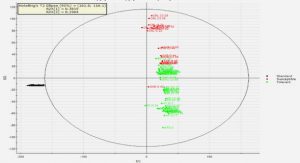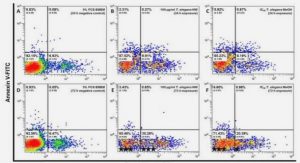Get Complete Project Material File(s) Now! »
Shelf life estimation UHT milk
To determine the shelf life of a product various factors need to be considered, including the nutritional deterioration, microbial growth and sensory deterioration (Singh, 2000). Since UHT milk is microbiologically stable over several months of storage, the shelf life is based on the sensory quality of the milk (Badings, 1991; Perkins et al., 2005). To design a successful shelf life study probable causes of product quality deterioration or failure need to be determined. For a shelf stable product like UHT milk, the most common mode of failure is sensory failure due to physico-chemical degradation. These modes of failure, including colour changes, loss of desirable sensory attributes and formation of undesirable sensory attributes, can be influenced by the compositional, packaging and storage factors (Azzara & Campbell, 1992; Aroonkamonsri,et al., 1996; Jovanka et al., 2008.
Accelerated shelf life
When products have long shelf lives under normal storage conditions, accelerated shelf life testing (ASLT) can be applied where the shelf life of the food is tested under environmental conditions that accelerate the quality deterioration of the food. The results obtained from the accelerated test can then be extrapolated to normal conditions of storage (Meeker & Escobar, 1998; Corrigan et al., 2012). When ASLT is performed, the compositional factors must be kept constant while another factor must be chosen to accelerate the loss of quality of the food product over time. Various factors are known to be potential acceleration factors, including temperature, relative humidity, gas partial pressure and light intensity (Meeker & Escobar, 1998). Accelerated shelf life test do, however, include some liminations. These limitations include changes in the physical state of products as the temperature increases which can affect the rate of some reactions, storage at constant elevated temperatures with lower than normal relative humidity can lead to unexpected results, the mechanism of spoilage may change at elevated temperatures, and the Arrhenius model on which accelerated tests are based by not be appropriate for more complex chemical systems (IFST, 1993; Mizrahi, 2000).
Temperature as acceleration factor
To get an overall idea of the evolution of an attribute (A), the A value can be plotted as a function of storage time (t) with constant packaging and environmental variables. Equation 1.1 explains the kinetics of A during storage time and this can range from a simple straight line to a number of complex evolutions. The most common method for experimental data analysis to determine the rate of food quality decay is to apply the principles of classical kinetic theory. According to this approach the rate of change (r) in the attribute can be defined by: r = dA/dt = kAn (1.1) where k represents the reaction rate constant, t the storage time and n the reaction order (Fu & Labuza, 1993; Taoukis, Labuza,& Saguy, 1997). Table 2.1 shows the integrated equations for n = 0, 1, 2 and also the general equation used for n ≠ 1. To identify the proper reaction order the experimental values expressed as A, ln A, 1/A, 1/A n-1 are plotted against t and the appropriate order corresponds to a linear pattern of points. That is followed by determining the two parameters of the kinetic function, the rate constant (k) and A0, from the experimental data. Due to the complexity and heterogeneous nature of food, there is often not a theoretical reason to choose a specific reaction order. For this reason, alternative models of empirical nature are often considered (Corradini & Peleg, 2006).
Survival analysis
Survival analysis methodology was used to determine the end of shelf life for UHT milk stored at 45°C, using the results obtained from consumers when asked if they would normally consume the samples with different storage times. The cut-off point was then determined by using this value in the regression equation for the PC1 scores plotted against time. A random variable T can be defined as the storage time on which the consumer rejects the sample, but due to the consumers evaluating a limited number of samples with different storage times, the exact T could not be observed, thus the censored nature of the data (Hough, Langohr, & Gómez, 2003). When consumers are presented with samples stored at times t1, t2 and t3 and a consumer rejects the sample at the first storage time, the point of rejection for that consumer is not observed since it is before the first storage time (T ≤ t1) and the data are left censored.
If the consumer accepts the sample stored for t1 but rejects the sample stored for t2, the exact time at which the consumer rejects the product occurs between t1 and t2 (t1 < T ≤ t2) and the data are interval censored. If, however, the consumer accepts all the samples, the point of rejection is after the last storage time observed (T > t3) and the data is right censored. The survival function S (t) can be defined as the probability of a consumer accepting a product stored for a time period longer than t, S (t) = P (T > t). Parametric models were be used to obtain precise estimates of the survival function (Klein & Moeschberger, 1997). Various distributions, including log-normal, Weibull, logistic, Gaussian, log logistic and exponential, were fitted to the data using R statistical software (R Development Core team, 2010). The end of shelf life for the low fat UHT milk stored at 45°C was estimated using a 50% rejection level. Only data from consumers that did not reject the freshest sample (6 d) were included in the analysis, as per Hough, Garitta, and Gómez, (2006).
RESULTS AND DISCUSSION
The freshly packed low fat UHT milk used during this study showed satisfactory milk composition and microbiological quality (Table 3.2). Smit and Schönfeldt (2006) reported the values for the fat, protein and lactose content of low fat UHT milk as 1.86%, 3.33% and 4.9%, respectively. The nutritional values for the low fat UHT milk correlate well with these values. Literature state that UHT processing renders milk bacteriologically stable at ambient temperatures for several months (Lewis & Heppell, 2000; Valero et al., 2001). The microbiological quality of the freshly packed low fat UHT milk was very high with counts of <1 mL-1 E. coli, coliforms and spore formers and counts of <1.1000 mL-1 for total counts. The microbiological quality was maintained throughout the duration of the study, showing no significant increase for either total counts or aerobic spores (Table 3.3). These results complied with the specifications of the South African Bureau of Standards that states that heat-treated milk should not contain more than 50 colony forming units (cfu) per mL and should be free of any coliform bacteria, while UHT milk should be free of any bacteria.
TABLE OF CONTENTS :
- CHAPTER 1 : INTRODUCTION
- 1.1 References
- CHAPTER 2 : LITERATURE REVIEW
- 2.1 MILK PROCESSING
- 2.2 UHT PROCESSING
- 2.2.1 Direct UHT system
- 2.2.2 Indirect UHT system
- 2.2.3 Aseptic packaging
- 2.3 SHELF LIFE OF UHT MILK
- 2.3.1 Factors affecting UHT milk quality
- 2.3.2 Measures taken to reduce sensory defects in UHT milk
- 2.3.3 Measures taken to reduce enzymatic and consistency defects in UHT milk
- 2.3.4 Shelf life estimation UHT milk
- 2.4 CONCLUSION
- 2.5 REFERENCES
- CHAPTER 3 : MULTIVARIATE ACCELERATED SHELF LIFE TEST OF LOW FAT UHT MILK
- 3.1 INTRODUCTION
- 3.2 MATERIALS AND METHODS
- 3.2.1 Samples and sample preparation
- 3.2.2 Sensory evaluation of UHT milk
- 3.2.3 Cut-off point determination using survival analysis
- 3.2.4 Nutritional and microbiological analyses of low fat UHT milk
- 3.2.5 Statistical data analysis
- 3.3 RESULTS AND DISCUSSION
- 3.4 CONCLUSION
- 3.5 REFERENCES
- CHAPTER 4 : SURVIVAL ANALYSIS, CONSUMER PERCEPTION AND PHYSICO-CHEMICAL ANALYSIS OF LOW FAT UHT MILK STORED FOR DIFFERENT TIME PERIODS
- 4.1 INTRODUCTION
- 4.2 METHODS AND MATERIALS
- 4.2.1 Consumer evaluation
- 4.2.2 Physico-chemical analysis
- 4.2.3 Enzymatic reactions
- 4.2.4 Statistical data analysis
- 4.3 RESULTS AND DISCUSSION
- 4.3.1 Survival analysis
- 4.3.2 Consumers’ liking and CATA
- 4.3.3 Physico-chemical and enzymatic reactions
- 4.3.4 Correspondence analysis
- 4.4 CONCLUSION
- 4.5 REFERENCES
- CHAPTER 5 : THE EFFECT OF LEGUME PROTEASE INHIBITORS ON NATIVE MILK AND BACTERIAL PROTEASES
- Abstract
- 5.1 INTRODUCTION
- 5.2 MATERIALS AND METHODS
- 5.2.1 Materials and chemicals
- 5.2.2 Protease inhibitor extraction
- 5.2.3 Characterization of protein extract
- 5.2.4 Inhibition of bacterial protease and plasmin activity in buffer
- 5.2.5 Inhibition of bacterial protease and plasmin activity in low fat UHT milk
- 5.2.6 Statistical analysis
- 5.3 RESULTS AND DISCUSSION
- 5.3.1 Characterization of the protein extracts from legume seeds
- 5.3.2 Inhibition of protease activity in buffer
- 5.3.3 Inhibition of protease activity in low fat UHT milk
- 5.4 CONCLUSION
- 5.5 REFERENCES
- CHAPTER 6 : GENERAL DISCUSSION
- 6.1 SHELF LIFE METHODOLOGIES
- 6.2 LOW FAT UHT MILK SHELF LIFE ESTIMATION AND APPLICATION
- 6.3 PROTEASE INHIBITION IN UHT MILK
- 6.4 REFERENCES
- CHAPTER 7 : CONCLUSIONS
GET THE COMPLETE PROJECT
Sensory and enzymatic factors associated with defects in low fat UHT milk






